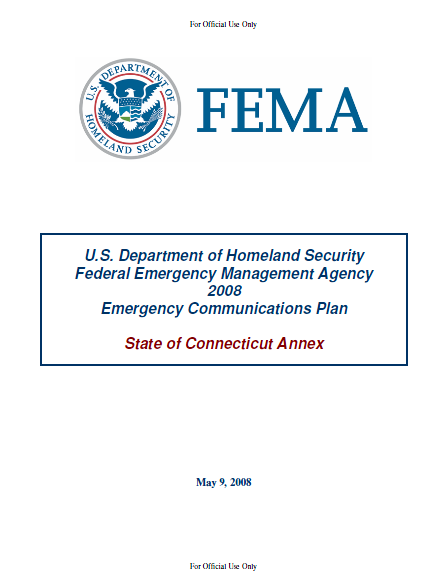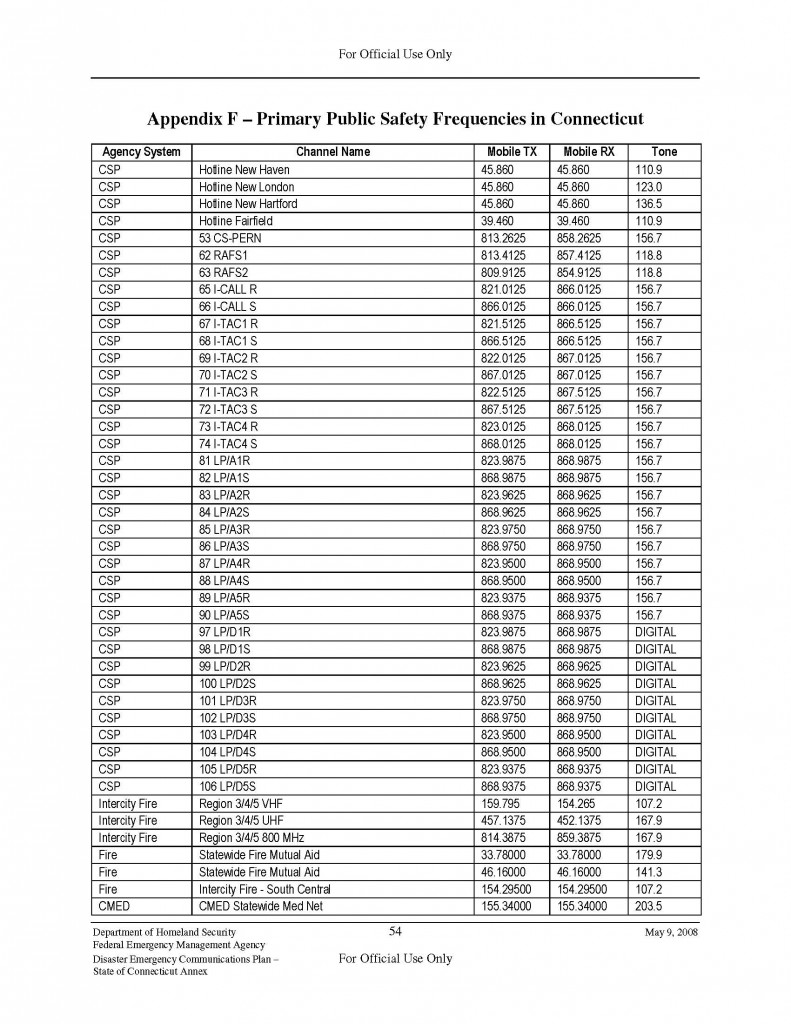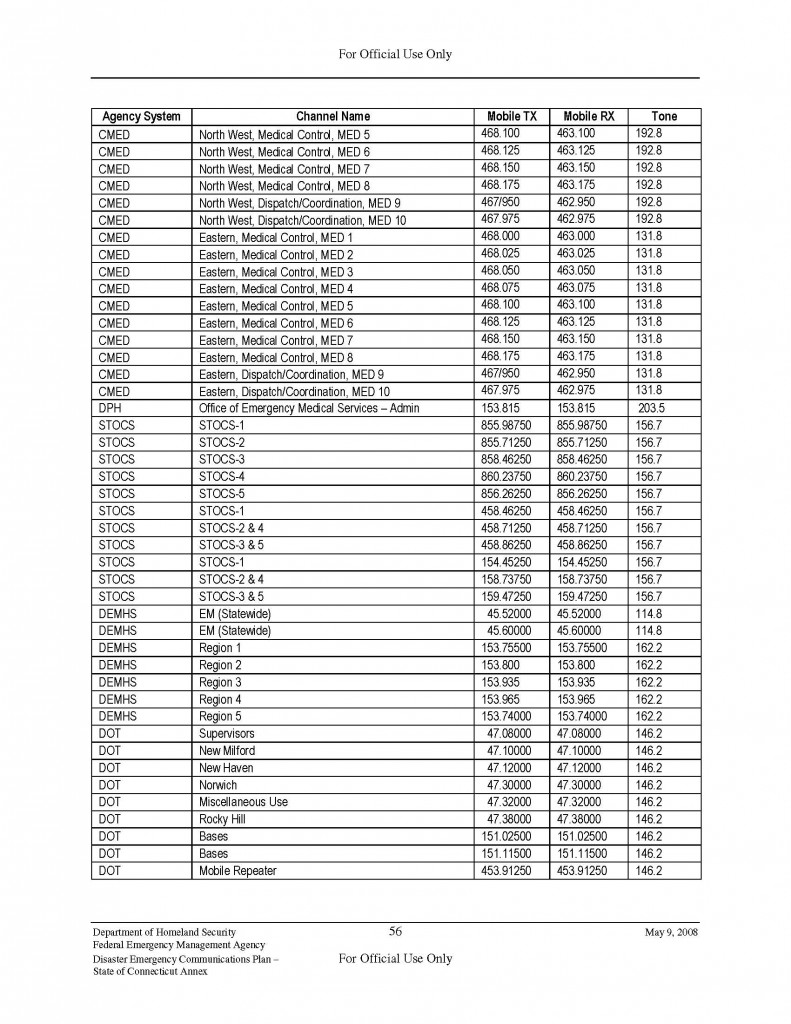 Federal Emergency Management Agency
Federal Emergency Management Agency
- 62 pages
- For Official Use Only
- May 9, 2008
Executive Summary
The Federal Emergency Management Agency (FEMA) disaster emergency communications planning team was charged with developing comprehensive and integrated federal, state, and local communications plans for high-risk communities, in preparation for the 2008 hurricane season. The team was led by FEMA and included representatives of the following agencies:
• Department of Emergency Management and Homeland Security (DEMHS)
• Department of Information Technology (DoIT)
• Connecticut State Police (CSP)
• Connecticut Department of Transportation (CDOT)
• Connecticut Department of Environmental Protection (CDEP)
• Connecticut Department of Public Health (CT-DPH)
• Connecticut Regions I through V; ESF II representatives and Coordinated Medical Emergency Dispatch (CMED) Centers
• Connecticut Air National Guard (CANG)
• Connecticut National Guard (CTNG)
• Amateur Radio Emergency Service of Connecticut (ARES)
• American Red Cross of Connecticut (ARC)The team met with state and local representatives to identify communications requirements and discuss potential solutions. The team reviewed state and local communications plans and capabilities, and evaluated the impact that a disruption in communications services would have in areas affected by a hurricane.
The team focused on five strategic areas in the development of this document: risk assessment
and mitigation planning, operability and interoperability, communications availability,
integration and coordination of Federal resources, and pre-positioning of communications
resources. There were seven mission operations focus areas for this document: command and
control (C2), evacuation, sheltering, search and rescue (SAR), commodities, medical, and debris
removal.The most significant findings are the following:
• The State of Connecticut has identified interoperable communications as a priority in its
emergency response and disaster recovery planning efforts. The Connecticut Public Safety
State Executive Interoperability Committee (CPSSEIC) is comprised of emergency
management and communications experts from throughout the state. CPSSEIC meets
regularly to determine communication equipment requirements, provide grants guidance,
and develop training and exercise requirements. The Connecticut Department of Public
Safety (DPS) operates an 800 megahertz (MHz) digital trunked radio network that provides
the backbone for a statewide radio system and currently supports CSP operations and ICALL
/ I-TAC frequencies in the state. All state agencies will have access to the DPS
network during disasters, and deployable communications assets are available to enable
interoperability between state and local emergency responders.• State and local agency radio communications systems vary widely from conventional (e.g.,
very high frequency [VHF] low-band) to more sophisticated trunked digital systems,
reflecting terrain, building density, and financial considerations. Local communications
networks and equipment are vulnerable to damage from a Category 3 hurricane. Federal
assistance will be required to supply temporary VHF and ultra high frequency (UHF)
networks, including radio base stations and associated repeaters, radio towers, and antennas
to temporarily restore local radio systems.• Several radio towers in the state have been identified as being vulnerable to storm damage.
If these towers are damaged during a hurricane or strong storm, radio communications
among emergency responders inside the incident area will be compromised. At present, the
state has no spare mobile radio towers to temporarily restore service at these vulnerable
locations. FEMA should be prepared to temporarily restore communications capabilities at
up to 18 vulnerable radio tower locations in Connecticut.• Currently, no facilities have been designated for use as a back-up State Emergency
Operations Center (SEOC) or Emergency Communications Center (ECC) for DoIT. Both
facilities are in at-risk locations that are vulnerable to flooding. DEMHS is now designating
a regional facility for use as a secondary SEOC location and acquiring a mobile command
post that could serve as an alternate SEOC, however these efforts will not be complete
before the 2008 hurricane season. DoIT’s plans for a back-up ECC are in an early stage of
development and are not yet funded. FEMA must be prepared to provide communications
resources for a temporary back-up SEOC for up to 20 people and a mobile back-up facility
for the DoIT ECC in the event either or both primary facilities become untenable.• Local government agencies manage the sheltering of evacuees and displaced persons, which
will be a major task if a hurricane or strong storm affects Connecticut. The American Red
Cross will provide staffing and operational support at designated shelter locations. Wired
and cellular public switched telephone networks (PSTN) are the primary means of voice
and data communications for sheltering operations and may be affected as a result of storm
damage, particularly in areas subject to flooding. Local ARES personnel provide back-up
communications support, but these personnel are few in number. FEMA should be prepared
to provide communications capabilities for shelter staff and shelter coordination personnel
if a failure of commercial wired and wireless networks occurs.• Communications technicians are also in short supply. If a local or the statewide radio
system becomes impaired, supplemental telecommunications technicians will be needed to
repair and restore damaged equipment, program additional radios to enable effective
communications among emergency responders from out of the area, provide system
interoperability, act as radio operators, and relieve local communications personnel. FEMA
should be prepared to provide trained telecommunications technicians to not only assist in
the repair and recovery of local and state communications systems but also ensure the
timely restoration of vital communication links.…



